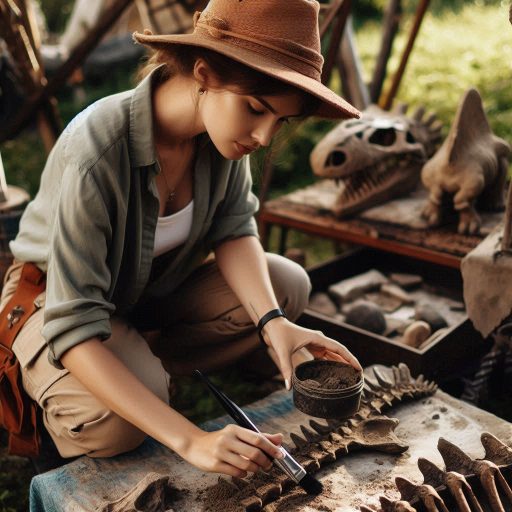Introduction
Famous archaeological discoveries reveal the mysteries of ancient civilizations.
These finds provide valuable insights into history and culture.
Archaeologists uncover artifacts, structures, and texts that shape our understanding of past societies.
Each discovery contributes to a broader picture of human development and cultural evolution.
The significance of these discoveries extends beyond mere artifacts.
They help us understand the beliefs, practices, and daily lives of people long ago.
These finds bridge the gap between ancient and modern societies.
They allow us to appreciate the achievements and challenges faced by our ancestors.
This blog post explores some of the most renowned archaeological discoveries.
We will examine their historical context, the artifacts unearthed, and their cultural significance.
Each discovery has left a lasting impact on our understanding of human history.
By studying these remarkable finds, we gain insights into ancient civilizations.
We learn how they lived, what they valued, and how they influenced the world.
Join us as we delve into these extraordinary archaeological discoveries and uncover their importance in shaping our understanding of history.
The discovery of the tomb of King Tutankhamun in Egypt
Discovery of King Tut’s Tomb by Howard Carter in 1922
In 1922, British archaeologist Howard Carter made a groundbreaking discovery in Egypt.
He uncovered the tomb of King Tutankhamun in the Valley of the Kings.
This momentous event occurred after years of searching for lost tombs in the region.
The tomb, designated KV62, remained largely untouched for over 3,000 years.
Carter’s discovery captured the world‘s imagination and set the stage for modern archaeology.
Treasures Found in the Tomb and Their Significance in Understanding Ancient Egyptian Culture
Inside the tomb, Carter found an astonishing wealth of treasures.
These artifacts included gold masks, jewelry, and ornate furniture.
The most famous artifact was the golden burial mask of Tutankhamun.
This exquisite piece exemplified the craftsmanship of ancient Egyptian artisans.
Other notable finds included chariots, weapons, and canopic jars containing the king’s organs.
The treasures revealed much about ancient Egyptian culture and beliefs.
They demonstrated the importance of the afterlife in Egyptian society.
The lavish items signified the wealth and power of the young pharaoh.
Additionally, inscriptions and artworks in the tomb provided insights into ancient rituals and daily life.
How This Discovery Sparked a Global Fascination with Archaeology and Ancient Egypt
Carter’s discovery sparked a global fascination with archaeology and ancient Egypt.
Newspapers across the world reported on the findings, igniting public interest.
People became captivated by the idea of uncovering lost civilizations and hidden treasures.
The phrase “King Tut” became synonymous with the allure of ancient Egypt.
This excitement led to a surge in archaeological expeditions and museum exhibitions.
Exhibitions showcasing Tutankhamun’s treasures toured globally, attracting millions of visitors.
These events increased awareness of Egypt’s rich history and cultural heritage.
They also emphasized the significance of preserving archaeological sites for future generations.
Moreover, the discovery influenced popular culture.
Films, books, and documentaries about ancient Egypt became increasingly popular.
The mystique surrounding King Tutankhamun became a cultural phenomenon.
This interest encouraged the study of ancient Egypt and its contributions to human civilization.
Carter’s discovery fundamentally changed the field of archaeology.
It demonstrated the potential for significant finds in seemingly unremarkable locations.
The methods employed by Carter and his team set new standards for archaeological research.
Their work emphasized careful excavation and documentation.
The discovery of King Tutankhamun’s tomb in 1922 marked a pivotal moment in archaeology.
The treasures found within illuminated aspects of ancient Egyptian culture and beliefs.
This monumental discovery sparked global fascination, influencing public interest and cultural representations of ancient Egypt.
The legacy of King Tut continues to inspire both scholars and enthusiasts today.
Read: Top Skills Needed for a Successful Geology Career
The excavation of Pompeii and Herculaneum in Italy
History of the Ancient Roman Cities of Pompeii and Herculaneum
Pompeii and Herculaneum were vibrant Roman cities located near the Bay of Naples.
Pompeii had a population of approximately 11,000 people.
Herculaneum was smaller, housing around 5,000 residents.
Both cities flourished during the Roman Empire, showcasing advanced urban planning and architecture.
They featured impressive buildings, public baths, and bustling markets.
The cities offered a glimpse into everyday Roman life, culture, and social structure.
Eruption of Mount Vesuvius in 79 AD That Buried the Cities
On August 24, 79 AD, Mount Vesuvius erupted violently, blanketing both cities in ash and pumice.
The eruption released a cloud of stones, ashes, and fumes to a height of 33 km.
The cities faced destruction as they were buried under volcanic material.
This catastrophic event preserved many structures and artifacts for centuries.
The people of Pompeii and Herculaneum were caught off guard, leading to many casualties.
Some residents managed to escape, but many others perished.
Archaeological Findings in Both Cities and Their Impact on Our Understanding of Roman Society and Daily Life
Archaeological excavations began in the 18th century and continue to this day.
Excavations at Pompeii revealed remarkably preserved buildings, frescoes, and everyday objects.
Streets, homes, and public spaces appeared much like they did before the eruption.
Findings included tools, pottery, and even food, offering a glimpse into daily life.
Herculaneum provided even more insights due to its unique preservation.
The volcanic material carbonized organic materials, preserving wooden structures and artifacts.
Archaeologists uncovered well-preserved manuscripts, providing valuable information about Roman literature and education.
The discoveries at both sites revealed the sophistication of Roman society and its cultural practices.
Artifacts uncovered at Pompeii and Herculaneum illustrate social hierarchy and daily activities.
They show the roles of different classes within society, from wealthy elites to laborers.
Many frescoes depict mythological scenes, showcasing Roman artistic achievements.
The public baths in both cities highlight the importance of hygiene and social interaction.
The findings revolutionized our understanding of ancient Roman civilization.
They allowed historians to reconstruct aspects of daily life, architecture, and social customs.
The preserved environments offered unparalleled opportunities to study Roman urban life.
Visitors today can walk through the streets of Pompeii, experiencing the city as it was.
The excavation of Pompeii and Herculaneum provides invaluable insights into ancient Roman life.
The eruption of Mount Vesuvius in 79 AD preserved these cities in time.
Archaeological findings have enriched our understanding of Roman culture, society, and daily life.
Read: The Future of Botany: Emerging Fields and Innovations
The Rosetta Stone and its role in deciphering Egyptian hieroglyphs
Background Information on the Rosetta Stone and Its Discovery in Egypt in 1799
The Rosetta Stone is a granodiorite stele discovered in 1799.
French soldiers found it near the town of Rosetta, now Rashid, during Napoleon‘s campaign in Egypt.
The stone features a decree issued in 196 BC, celebrating the reign of Ptolemy V.
What makes the Rosetta Stone unique is its inscription in three scripts: Greek, Demotic, and hieroglyphs.
The Greek script provided a known language that would help scholars unlock the other two scripts.
After its discovery, the British captured the stone during the Napoleonic Wars.
They transported it to England, where it remains today in the British Museum.
The stone’s significance quickly became apparent to scholars and historians.
The combination of languages offered a key to understanding ancient Egyptian writing.
How Scholars Used the Stone to Decipher Egyptian Hieroglyphs
Scholars quickly recognized the potential of the Rosetta Stone for understanding hieroglyphs.
Jean-Fran‘ois Champollion played a crucial role in deciphering the stone.
He studied the Greek text to identify names and words.
Champollion noticed that the hieroglyphs represented both sounds and meanings.
He compared the hieroglyphs with the Greek text, leading to significant breakthroughs.
Using this method, Champollion identified proper names such as “Ptolemy” and “Cleopatra.”
He established that hieroglyphs were a phonetic script, rather than just symbolic.
His work laid the foundation for further studies of Egyptian writing.
Other scholars built upon his discoveries, deepening their understanding of hieroglyphs and the Demotic script.
Importance of This Discovery in Unlocking the Secrets of Ancient Egyptian Writing
The deciphering of the Rosetta Stone unlocked the secrets of ancient Egyptian writing.
It allowed scholars to read inscriptions on temples, tombs, and monuments.
This understanding provided valuable insights into Egyptian history, culture, and religion.
Historians could now access primary texts that revealed ancient beliefs, practices, and governance.
The impact of this discovery extended beyond Egyptology.
It transformed the study of ancient civilizations by demonstrating the importance of linguistic connections.
The methods used to decipher the stone established a framework for interpreting other ancient scripts.
Scholars began to apply similar techniques to other languages and cultures, fostering interdisciplinary research.
Furthermore, the Rosetta Stone became a symbol of linguistic and cultural exploration.
It sparked widespread interest in Egyptology and the study of ancient texts.
Museums and universities around the world began to invest in Egyptian studies, driven by the excitement surrounding the stone.
The Rosetta Stone played a pivotal role in deciphering Egyptian hieroglyphs.
Its discovery in 1799 provided scholars with a crucial linguistic tool.
The work of researchers like Champollion opened the door to understanding ancient Egyptian writing and culture.
This monumental achievement transformed the field of Egyptology and enriched our knowledge of human history.
Read: What Does a Geologist Do? Career Overview and Insights

The excavation of Machu Picchu in Peru
Rediscovery of Machu Picchu by Hiram Bingham in 1911
In 1911, Hiram Bingham, an American historian and explorer, rediscovered Machu Picchu.
He traveled to Peru seeking the lost Inca city.
Local farmers led Bingham to the site, hidden in the Andes Mountains.
Bingham documented his findings, which included extensive ruins and terraces.
He recognized the site’s archaeological significance and began excavation.
Bingham‘s expedition attracted attention, leading to widespread interest in Machu Picchu.
He brought artifacts to the United States, sparking further research.
Bingham’s accounts helped popularize the site, although some questioned his methods and ownership of artifacts.
Nonetheless, his discovery marked a turning point in the study of Inca civilization.
Significance of the Inca Citadel in Understanding Incan Civilization
Machu Picchu holds immense significance in understanding the Inca civilization.
The site showcases advanced engineering and architectural skills.
Its terraced fields demonstrated sophisticated agricultural practices, crucial for sustaining large populations.
The construction methods employed at Machu Picchu reveal the Incas‘ ability to adapt to their environment.
Archaeologists believe Machu Picchu served as a royal estate or religious site.
The layout includes temples, plazas, and residential areas, reflecting the societal structure of the Incas.
Researchers study the site to learn about Inca religion, politics, and daily life.
Artifacts found during excavations offer insights into Inca culture and trade networks.
The presence of ceremonial structures, such as the Temple of the Sun, indicates religious significance.
These findings enhance our understanding of Inca cosmology and rituals.
Machu Picchu serves as a window into the past, illuminating the complexities of Inca society.
How Machu Picchu Has Become a Symbol of Ancient American Civilizations
Machu Picchu has become an iconic symbol of ancient American civilizations.
Its breathtaking location and intricate architecture attract millions of visitors annually.
Tourists from around the world visit to experience the site’s beauty and history.
The citadel represents the ingenuity and resilience of the Inca people.
The site also embodies the broader narrative of pre-Columbian civilizations.
It challenges stereotypes about ancient cultures in the Americas, highlighting their achievements.
Machu Picchu inspires contemporary discussions about cultural heritage and preservation.
Many advocate for protecting the site from environmental and tourist pressures.
Furthermore, Machu Picchu‘s status as a UNESCO World Heritage site emphasizes its global significance.
The designation aids in conservation efforts and promotes awareness of Inca history.
It also fosters international collaboration in archaeological research and preservation.
The excavation of Machu Picchu has profoundly impacted our understanding of Incan civilization.
Hiram Bingham’s rediscovery in 1911 opened doors to a deeper appreciation of ancient cultures.
Today, Machu Picchu stands as a powerful symbol of the achievements of the Inca and other ancient American civilizations.
Read: Educational Path: Becoming a Geologist in the USA
See Related Content: Breaking Into Space Science: Tips for New Graduates
The Terracotta Army in China
Terracotta Army and Its Discovery in 1974 Near the Tomb of Emperor Qin Shi Huang
The Terracotta Army is an extraordinary archaeological find in China.
Discovered in 1974, it lies near the tomb of Emperor Qin Shi Huang.
Farmers digging a well stumbled upon the remarkable site.
They uncovered the first life-sized clay soldier, sparking immense interest.
Archaeologists quickly recognized the significance of this find.
Qin Shi Huang was the first emperor of a unified China.
He ruled from 221 to 210 BC and sought to ensure his immortality.
The Terracotta Army was created to accompany him in the afterlife.
It reflects the emperor‘s beliefs in life after death and the afterlife.
The discovery of the Terracotta Army captivated the world.
It provided insights into ancient Chinese civilization, art, and military practices.
The site has since become one of China‘s most visited tourist attractions.
Transform Your Career Today
Unlock a personalized career strategy that drives real results. Get tailored advice and a roadmap designed just for you.
Start NowThousands of Life-Sized Clay Soldiers, Horses, and Chariots Found in the Tomb
The Terracotta Army consists of thousands of life-sized clay soldiers, horses, and chariots.
Archaeologists estimate that around 8,000 soldiers exist, along with 670 horses and 130 chariots.
Each soldier varies in height, attire, and facial features, reflecting real soldiers of that time.
The level of detail is astonishing, showcasing advanced craftsmanship.
The army is arranged in battle formation, ready to protect the emperor in the afterlife.
Various ranks are represented, including archers, infantry, and cavalry.
The soldiers carry weapons, such as swords, spears, and crossbows, all crafted with precision.
Additionally, the tomb complex contains various artifacts, including pottery and bronze items.
These findings illustrate the culture and technology of the Qin Dynasty.
The Terracotta Army provides a glimpse into the military organization and tactics of ancient China.
Impact of This Discovery on Our Knowledge of Ancient Chinese History and Funerary Practices
The discovery of the Terracotta Army significantly impacted our understanding of ancient Chinese history.
It revealed insights into the Qin Dynasty’s military and political structure.
The army demonstrated the emperor‘s desire for control and order, even in death.
Furthermore, the Terracotta Army highlighted ancient Chinese funerary practices.
It showcased the belief in an afterlife, where the dead required protection and companionship.
This practice reflects broader trends in burial customs across different cultures.
The excavation also shed light on the artistry and craftsmanship of ancient China.
The skilled artisans who created the army left a lasting legacy.
Their work has influenced modern interpretations of Chinese history and culture.
Today, the Terracotta Army remains a UNESCO World Heritage site.
It draws researchers and tourists eager to learn about ancient China.
The site continues to provide valuable information about the Qin Dynasty and its impact on Chinese civilization.
The Terracotta Army is a monumental discovery that transformed our understanding of ancient China.
It reveals the military, cultural, and funerary practices of the time.
This incredible site stands as a testament to the power and vision of Emperor Qin Shi Huang.
The Dead Sea Scrolls in Israel
Discovery of the Dead Sea Scrolls in Caves Near the Dead Sea in the Mid-20th Century
The Dead Sea Scrolls were discovered in the mid-20th century in Israel.
A Bedouin shepherd found the first scrolls in 1947.
He stumbled upon the scrolls while searching for a lost goat in a cave.
The discovery occurred near the Dead Sea, close to Qumran.
Excavations followed the initial find, uncovering eleven caves containing scrolls.
Archaeologists retrieved numerous ancient manuscripts from these caves.
The scrolls date back to between 150 BCE and 70 CE.
They are some of the oldest known biblical texts.
The discovery of the Dead Sea Scrolls was monumental for scholars.
It provided valuable insights into ancient Jewish culture and religious practices.
Researchers began to study these manuscripts extensively, leading to new understandings of historical contexts.
Religious and Historical Significance of These Ancient Manuscripts
The Dead Sea Scrolls hold immense religious significance.
They include texts from the Hebrew Bible, such as Isaiah and Psalms.
These manuscripts offer variations in biblical text, prompting reevaluation of the biblical canon.
Scholars analyze these differences to understand the evolution of scripture.
The scrolls also contain sectarian writings, revealing insights into the beliefs of the Essenes.
This Jewish group is believed to have lived near the Dead Sea during the Second Temple period.
Their writings discuss theology, community rules, and messianic expectations.
These ancient manuscripts illuminate the diversity of thought within Judaism during that era.
They help scholars understand the religious landscape that shaped early Christianity.
How the Dead Sea Scrolls Have Influenced Biblical Studies and Our Understanding of Jewish History
The Dead Sea Scrolls have profoundly influenced biblical studies.
They provide critical textual evidence for scholars examining the history of biblical texts.
The scrolls allow for comparisons with later versions of scripture, shedding light on textual transmission.
Additionally, they contribute to our understanding of Jewish history.
The scrolls reveal practices and beliefs that were prevalent before the destruction of the Second Temple.
They document the social and political context of Judaism during the late Second Temple period.
The discovery has also sparked discussions about the origins of Christianity.
The scrolls contain messianic expectations that resonate with early Christian beliefs.
Scholars continue to explore the connections between the Essenes and early Christians.
The Dead Sea Scrolls are invaluable for understanding ancient Judaism and early Christianity.
Their discovery has transformed biblical studies, prompting a reevaluation of religious texts and historical contexts.
The scrolls remain a vital resource for scholars and theologians alike, offering insights into the complexities of ancient faiths.
Uncover the Details: Seismology in Pop Culture: Movies and Media
Explore Further: The Impact of Pharmacologists on Public Health
Gain More Insights: Biomedical Engineering and the Future of Telemedicine
Conclusion
Famous archaeological discoveries have significantly impacted our understanding of history.
These findings have unveiled hidden aspects of ancient civilizations.
The Rosetta Stone decoded hieroglyphs, revolutionizing Egyptology.
The discovery of Pompeii sheds light on Roman daily life.
Tutankhamun’s tomb revealed treasures of ancient Egypt.
These discoveries preserve cultural heritage for future generations.
They provide valuable insights into the past, shaping our present understanding.
Archaeology continues to reveal remarkable artifacts and stories.
It is crucial in piecing together the puzzle of human history.
By uncovering relics and remnants of lost civilizations, archaeologists preserve our heritage.
These findings not only enrich our knowledge but also inspire further exploration.
The impact of archaeological discoveries goes beyond mere excavation sites.
It contributes to global education and cultural appreciation.
These findings are integral to understanding the origins of human societies.
Archaeology plays a crucial role in connecting the dots of our collective past.
It bridges gaps between different cultures and brings us closer to our roots.
The importance of these discoveries cannot be overstated.
They are essential in preserving our cultural legacy and informing our future.
Archaeology remains a dynamic field that continues to unravel the mysteries of our past.
It reminds us of our shared history and the significance of preserving our heritage.
Through these discoveries, we gain a deeper appreciation for the civilizations that came before us.
[E-Books for Sale]
The Big Book of 500 High-Paying Jobs in America: Unlock Your Earning Potential
$19.99 • 500 High-Paying Jobs • 330 pages
Explore 500 high-paying jobs in America and learn how to boost your career, earn more, and achieve success!
See All 500 High-Paying Jobs of this E-Book
1001 Professions Without a Degree: High-Paying American Jobs You Can Start Now
$19.99 • 1001 Professions Without a Degree • 174 pages
Discover 1001 high-paying jobs without a degree! Unlock career tips, skills, and success strategies for just $19.99!




